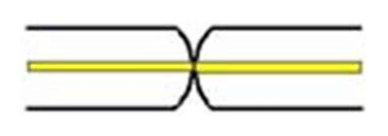FIBER POLISHES
The type of polish on a fiber affects the overall performance of a fiber optic system. Two main factors related to fiber polish are insertion loss and back reflection. Insertion loss refers to the fiber optic light lost when connecting equipment because of misaligned cores and air gaps. Back reflection refers to light being reflected back towards the source. This happens because of the different light refractive qualities of glass and air. Fiber with lesser quality polishes are subject to more insertion loss and back reflection.There are three main types of polishes that are currently used. They are physical contact (PC), ultra physical contact (UPC), and angled physical contact (APC). Each has its own performance characteristics as far as insertion loss and back reflection are concerned.
PC (Physical Contact)
- Ferrules physically touching each other
- Standard polish used for connectors on all multimode fiber and MTRJ connectors
- Typical back reflection of -40dB (lower number = better performance)
- Typical insertion loss between 0.20 - 0.30 dB

UPC (Ultra Physical Contact)
- Similar shape as PC but with lower back reflection
- Standard polish used for connectors on single-mode fiber
- Typical back reflection of -55dB
- Typical insertion loss between 0.20 - 0.30dB

APC (Angled Physical Contact)
- Ferrules have an 8 degree angle which minimizes back reflection
- The best polish offered
- Typical back reflection of -65fB
- Typical insertion loss between 0.25 - 0.35dB

| Polish Type | Back Reflection | Insertion Loss |
|---|---|---|
| Physical Contact (PC) | -40dB | 0.20 - 0.30dB |
| Ultra Physical Contact (UPC) | -55dB | 0.20 - 0.30dB |
| Angled Physical Contact (APC) | -65dB | 0.25 - 0.35dB |
This white paper is for informational purposes only and is subject to change without notice. C2G makes no guarantees, either expressed or implied, concerning the accuracy, completeness or reliability of the information found in this document.
